By Jehangir Parvereshi, sr. manager, customer engineering and Harpreet Chohan, director, marketing, SiTime
The explosive growth in internet-connected devices, or the internet of things (IoT), is driven by the convergence of people, devices and data across the web. Future growth will be strongly influenced by wearable technology as products transition from the laptop to the pocket to the body. Activity trackers are leading this segment in the number of units shipped per year, followed by smart watches and medical monitors/devices, as well as wearable cameras and smart glasses. These devices are enabled by advancements in MEMS and sensor technology, wireless connectivity and new power savings capability.
Wearable devices leverage new timing technology
All electronic products require one or more timing devices depending on the processor, partitioning, and various functions in the system. Traditionally, 32.768-kHz crystals and low-power MHz quartz-based oscillators have been used for implementing clock functions in battery-powered electronic systems. A new class of ultra-low-power, low-frequency MEMS oscillators now offers advantages over the ubiquitous 32-kHz crystal clock. Innovations in MEMS timing technology is making significant impact in IoT and wearables, especially in the areas of size and power savings.
Key benefits of MEMS timing solutions for IoT and wearables include:
- Smaller footprint—80% smaller than quartz
o Smallest 32-kHz oscillator in a 1.5 × 0.8-mm chip-scale package (CSP)
o Oscillator output drives multiple loads, reducing component count and board area
- Better stability, as good as 3 ppm—translates to higher savings
o MEMS XO (oscillator) is 2× to 3× more accurate compared to quartz
o MEMS TCXO (temperature compensated oscillator) is 30× to 40× more accurate
o Better stability means less reliance on network timekeeping updates, longer sleep-mode periods, and 30% to 50% lower power compared to quartz XTAL + SoC oscillator
- Programmable frequency from 1 Hz to 2.5 MHz for sensor interface—enables new architectural options
- More resilient—50× greater resistance to shock and vibration
All-silicon MEMS timing solutions
Unlike quartz-based devices, silicon MEMS oscillators employ modern packaging technologies. MEMS oscillators consist of a MEMS resonator die mounted on top of a high-performance, programmable analog oscillator IC that is molded into standard low-cost plastic SMD packages, with footprints compatible with quartz devices. To support the space requirements of ultra-small applications, SiTime MEMS oscillators are available in ultra-small CSPs. MEMS oscillators are based on a programmable architecture that allows customization of features including frequency, supply voltage, output swing, and other features.
Miniaturization through integration, smaller package size, and board layout flexibility
SiTime oscillators offer higher integration, new packaging options, and other features that enable size reduction. The SiT15xx 32kHz MEMS timing solutions are designed for replacing traditional quartz crystals in mobile, IoT, and wearable applications in which space and power are critical. These devices are also available in a 2.0 x 1.2-mm (2012) SMD package for designs that require crystal (XTAL) resonator compatibility. SiT15xx 2012 oscillators have power supply (Vdd) and ground (GND) pins in the center area between the two large XTAL pads, as shown in Fig. 1b .
For even smaller size, SiT15xx devices are available in a CSP (Fig. 1a ), which reduces the footprint by up to 80% compared to existing 2012 SMD crystal packages and is 60% smaller than the 1610 (1.6 × 1.0-mm) XTAL package. Another option, as a result of SiTime’s manufacturing processes, is the capability to integrate MEMS resonator die with an SoC, ASIC, or microprocessor die within a package. This option eliminates external timing components and provides the highest level of integration and size reduction. Due to the limitations of crystal resonators, quartz suppliers cannot offer CSP or integrated solutions.

Fig. 1: Package size and pin location of 32-kHz MEMS XO and TCXO compared to quartz XTALs.
Unlike quartz crystals, the SiT15xx output drives directly into the chipset’s XTAL-IN pin, eliminating the need for output load capacitors, as shown in Fig. 2 . Because the oscillator can drive clock signals over traces, it does not need to be placed adjacent to the chipset. This feature, combined with the ultra-low profile (0.55-mm height), enables flexibility in board layout and additional space optimization. In addition to eliminating external load capacitors, SiT15xx devices have special power supply filtering that eliminates the need for an external Vdd bypass-decoupling capacitor, further simplifying board design and miniaturization. Internal power supply filtering is designed to reject noise up to ±50 mVpp through 5 MHz.

Fig. 2: Total footprint of 32-kHz MEMS XO and TCXO compared to quartz XTAL and required capacitors.
Extended battery life through low current consumption
Low frequency, low power 32-kHz timekeeping devices are widely used in mobile devices where the device is continuously ON for time keeping or controlling sleep modes. These low frequency oscillators are also used to time events such as monitoring and control functions in a power management IC (PMIC) used in battery-powered devices or to perform short system wakeup for timing reference synchronization.

Fig. 3: SiT153x draws less than 1-µA oversupply and temperature.
Measured frequency stability
32-kHz MEMS timing devices have a temperature coefficient that is extremely flat across temperature compared to quartz crystals as shown in Fig. 4 . The SiT15xx oscillators are calibrated (trimmed) to guarantee frequency stability to less than 10 ppm at room temperature and less than 100 ppm over the full –40°C to 85°C temperature range. In contrast, quartz crystals have a classic tuning fork parabola temperature curve with a 25°C turnover point as indicated by the red lines in Fig. 4 .
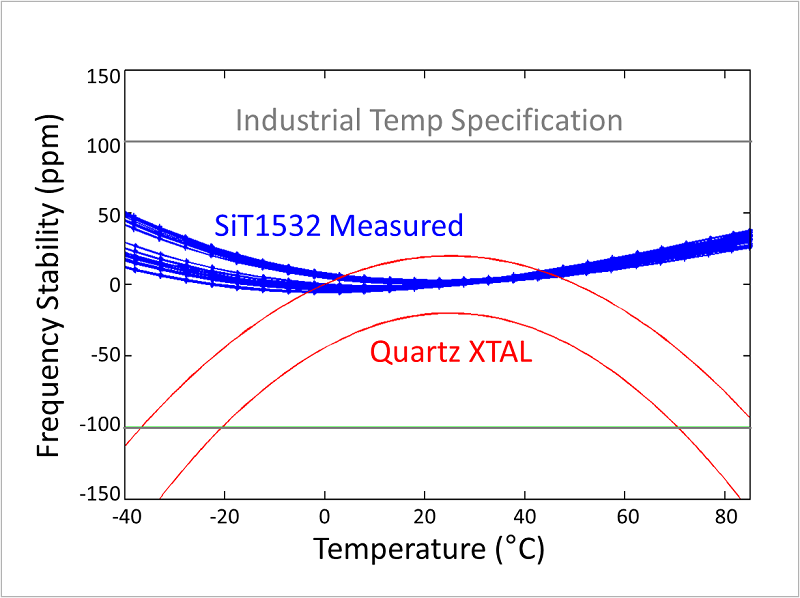
Fig. 4: SiT1532 32-kHz MEMS XO frequency stability compared to quartz XTAL –160 to –200 ppm over temp.
Fig. 5 plots the frequency stability of 32-kHz MEMS TCXOs. In these devices, the temperature coefficient is calibrated and corrected over temperature with an active temperature correction circuit. The result is a 32-kHz TCXO with less than 5-ppm frequency variation over temperature. This low level of frequency variation results in extremely accurate clocks that translate to significant power savings. With higher accuracy, wireless systems are less reliant on network timekeeping updates and can stay in sleep mode for much longer periods of time.
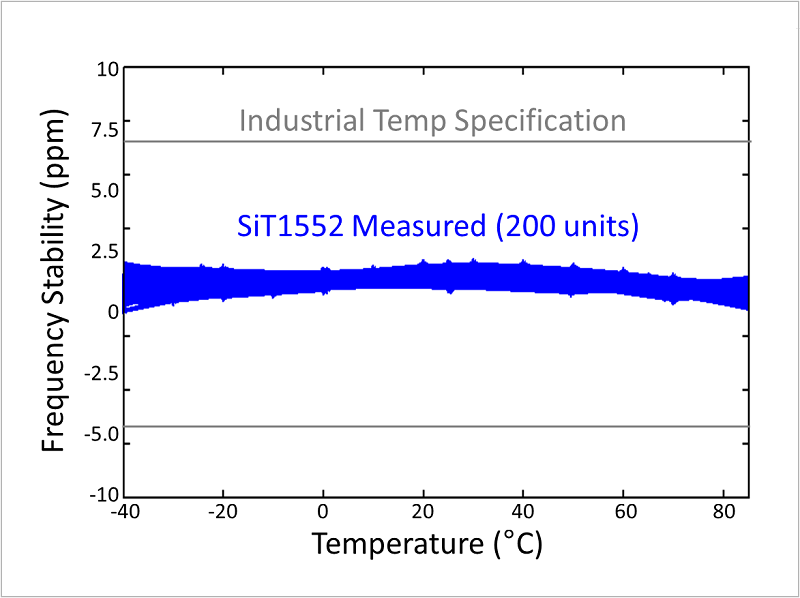
Fig. 5: SiT1552 MEMS TCXO frequency stability is 30 to 40 times more accurate than quartz XTAL.
Extended battery life through better frequency stability
Frequency stability, the clock’s stability over voltage and temperature, translates to power conservation. Many mobile and IoT devices reduce power consumption by shutting down the functional blocks with the highest current drain when inactive. However, the system must wake up and periodically communicate with the network. Higher frequency stability allows the device to stay in its low-power state, or sleep state, for longer periods, resulting in significant power savings.
Many wearables continuously collect data and compress and upload it to the cloud via an internet hub device such as a smartphone. This upload is transferred in short bursts that last a few milliseconds and then the device goes to sleep to conserve power. The cyclic sleep scenario is typical of battery-powered devices in which the device core is shut down for a pre-set time called “sleep time,” typically in the range of two to 10 seconds, and awoken when it needs to transmit data during a short burst. The connection event is the “ON” time during which certain functional blocks of the device wake up and stay active for short periods.

Fig. 6: Early ON time (or window widening) is affected by clock accuracy and causes a power penalty.
Power consumption is proportional to the ratio of “ON” time to the time that devices spend in the “sleep” state. And the sleep clock accuracy (SCA) of the 32-kHz clock that is used to time the sleep state has a direct impact on the battery life. Sleep clock inaccuracies cause the radio receiver (RX) to turn on earlier and stay on longer to avoid missing packets from the master. Clock inaccuracy, measured in ppm, extends early ON time (ΔT), as shown in Fig. 6 : ΔT = (SCA) × (SLEEP TIME).
The following table shows that tighter slave clock accuracy reduces early ON time, thereby reducing power consumption.
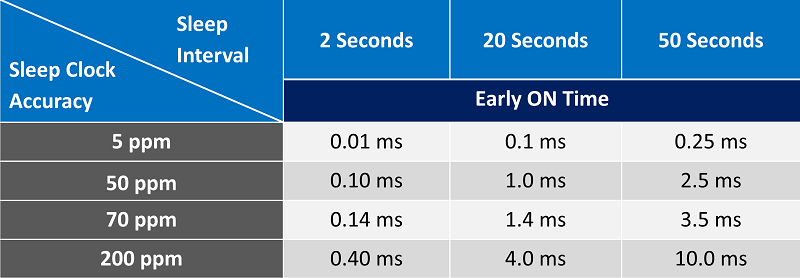
MEMS-based TCXOs, such as the SiT1552, with less than 5-ppm frequency variation over temperature, is a much more accurate alternative than quartz crystals. This accuracy reduces early ON time and allows the system to stay in sleep mode longer. Using a SiT1552, system designers can leverage compression and transmit data in short bursts only when required while keeping the device in its lowest-power sleep state for extended periods and potentially achieve up to twice the battery life.
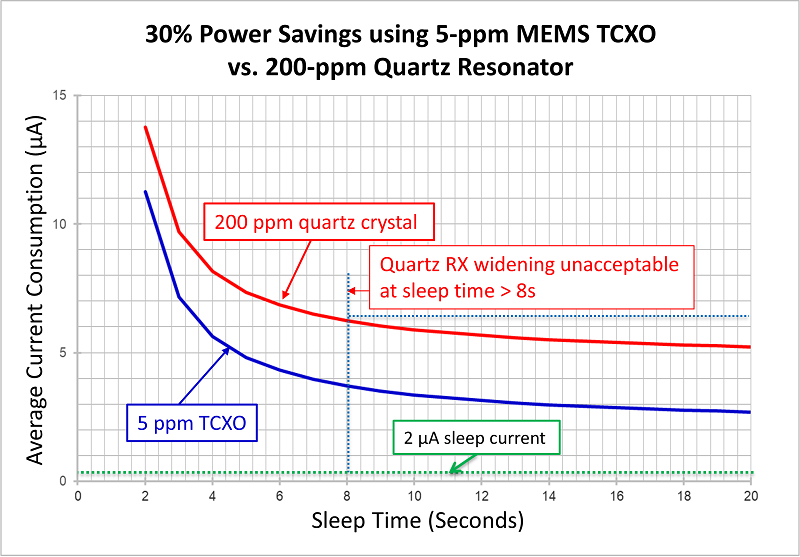
Fig. 7: Battery life through use of MEMS TCXO compared to quartz XTAL resonator.
Fig. 7 shows 30% power savings gained through using a 5-ppm 32-kHz TCXO compared to a 200-ppm 32-kHz quartz-crystal resonator. Shown are two plots of the average current consumption over 1 connection interval for various sleep times ranging from 2 seconds to 20 seconds. These per-cycle average values are computed from a BLE SoC sleep current of 1.8 µA, a radio receiver power of 9.3 mA, a transmit power of 9 mA, and an average ON-time base-band processing current of around 5 mA.
Extended battery life with programmable features
The analog oscillator IC in SiT15xx devices supports several functions, including a low noise sustaining circuit, an ultra-low-power precision PLL, and an ultra-low-power programmable output driver. The fractional-N PLL with sub-hertz resolution is used for device calibration and frequency programming from 2.5 MHz down to 1 Hz. The capability to lower output frequency significantly reduces current consumption. Quartz XTALs, due to the physical size limitations of the resonator at low frequencies, do not offer frequencies lower than 32.768 kHz. With lower-frequency options, the SiT15xx family enables new architecture possibilities in battery-powered applications in which the reference clock is always running.

Fig. 8: Unique NanoDrive output swing is programmable down to 200 mV to minimize power.
Unlike standard oscillators, SiT15xx oscillators can function in tandem with the on-chip 32-kHz oscillator circuit via the oscillator’s highly programmable output driver. The output driver can generate various common-mode voltages and swing levels to match different implementations of the on-chip 32-kHz oscillator circuits, as shown in Fig. 8 . This output swing is factory-programmable from full swing down to 200 mVpp for the lowest power. The ability to reduce output frequency and output driver current significantly reduces the output load current (C × V × F). See SiT15xx datasheets for load calculation details and examples at https://www.sitime.com/products/khz-oscillators and https://www.sitime.com/products/mpower-oscillators-1-hz-26-mhz .
MEMS are 50 times more robust
By nature of their application, IoT and wearables are used in a variety of environments and can be subjected to frequent and extreme mechanical shock and vibration. When operating in harsh environments, quartz oscillators will degrade and not conform to datasheet specifications. Some quartz oscillators are especially sensitive to sinusoidal vibration and shock and will exhibit significant frequency variation. The SiT15xx device architecture lends itself to higher reliability and resiliency to harsh environmental factors relative to their quartz counterparts. The very small mass (1,000 times smaller than quartz resonators) and structural design of SiTime resonators make them extremely immune to external forces such as vibration and shock. For more details on the resiliency and reliability of MEMS oscillators, see technology paper at: https://www.sitime.com/sites/default/files/gated/AN10045-SiTime-Resilience-Reliability-MEMS-Oscillators_0.pdf .
Application and design examples
In the wearable market, products are increasing in functionality while, at the same time, they must consume less power and space. 32-kHz MEMS timing solutions can be used for true pulse-per-second (pps) timekeeping, RTC reference clocking, and battery management timekeeping to lengthen battery life and shrink footprint.

Fig. 9: Typical wearable timing architecture.
Fig. 9 shows the clocking needs in a typical wearable device. A low power 32-bit MCU runs off of a 16-MHz crystal to clock the core and peripherals, and a 32-kHz crystal is used for real-time clocking. The MCU sends data to a connectivity chip that runs off of a 32-kHz crystal used for sleep clock timing.
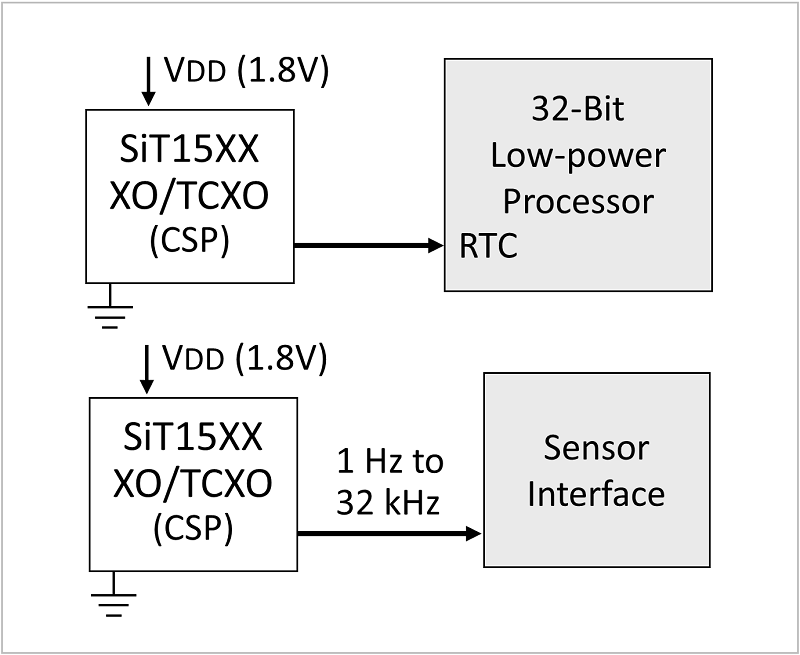
Fig. 10: Fitness device timing example 1.
Fig. 10 illustrates a design in which a programmable 1-Hz to 32-kHz SiT1534 MEMS oscillator is used for the sensor application and a 32-kHz MEMS SiT1532 reference clock drives the RTC in an MCU. In this design, the board space is reduced to less than half through use of 1.5 × 0.8-mm CSP oscillators.

Fig. 11: Fitness device timing example 2.
Fig. 11 shows an architecture in which a 32-kHz timing solution is required for two chips: a reference clock for the microcontroller and the sleep clock for the Bluetooth chip. In this design, a single MEMS timing device in a tiny 1.5 × 0.8-mm CSP, drives two loads and replaces two 32-kHz quartz XTALs. The footprint is eight times smaller than a design that uses two quartz XTALs in 2012 SMD packages plus the four required load capacitors. This design also saves significant power with 100-times-better stability of an SiT1552 TCXO compared to the BLE chip’s internal 32-kHz RC over temperature.
Summary
Innovation in the rapidly growing wearable and IoT segments is fueled by advancements in underlying technologies. MEMS timing technology is one of the key supporting technologies enabling the trend toward smaller size, lower power, and increased robustness.
MEMS timing reduces footprint through:
- Smaller, unique packages
- Higher integration that reduces component count
- Board layout flexibility
MEMS timing reduces power consumption through:
- Lower core current draw
- Higher frequency stability that enables longer sleep states
- Programmable frequency
- Programmable output swing voltage
MEMS timing increases robustness through:
- Greater resistance to shock and vibration error
MEMS XOs/TCXOs offer an alternative to the bulkier, less-accurate quartz-crystal clock sources used in past designs. As the IoT continues to expand with increasingly smaller battery-powered devices, low-frequency MEMS-based devices will provide the optimal timing solution and enable new products that were not previously possible.
Advertisement
Learn more about Electronic Products Magazine





